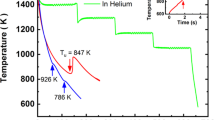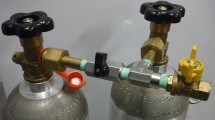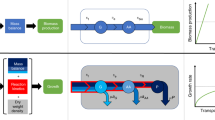Abstract
DURING a recent investigation, it was necessary to obtain large quantities of coliform organisms free from agar extractives and from complex peptide material. While working with a simple medium containing ammonium salts (or asparagine) and dextrose, it was found that an enormous increase in growth could be obtained by passing air through the medium. The following conditions were found to be essential to the success of this procedure. (1) The aeration had to be violent and unremitting, and sufficient to maintain the whole of the medium in a state of turbulence. (2) Media of a more complex nature, giving a positive biuret reaction, frothed excessively, and the common foam suppressors failed to control it. (3) The cooling effect of such an air stream was considerable, and immersion of the culture bottle in a water-bath was necessary to overcome this. A practical method of dealing with it in an incubator could not be found. (4) A moderately complex system of air sterilization was unavoidable. (5) Carbon and nitrogen in the medium had to be adjusted to meet the increased growth.
This is a preview of subscription content, access via your institution
Access options
Subscribe to this journal
Receive 51 print issues and online access
$199.00 per year
only $3.90 per issue
Buy this article
- Purchase on Springer Link
- Instant access to full article PDF
Prices may be subject to local taxes which are calculated during checkout
Similar content being viewed by others
Author information
Authors and Affiliations
Rights and permissions
About this article
Cite this article
ROBERTS, R. Influence of Aeration on Rate of Growth in Cultures. Nature 165, 494–495 (1950). https://doi.org/10.1038/165494a0
Issue Date:
DOI: https://doi.org/10.1038/165494a0
This article is cited by
-
Bact. coli as a Food Supplement
Nature (1953)
-
Effect of Aeration on the Absorption of Glucose by a Green Alga
Nature (1950)
Comments
By submitting a comment you agree to abide by our Terms and Community Guidelines. If you find something abusive or that does not comply with our terms or guidelines please flag it as inappropriate.



